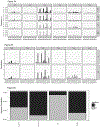Implication of DNA repair genes in Lynch-like syndrome
- PMID: 30989425
- PMCID: PMC6561810
- DOI: 10.1007/s10689-019-00128-6
Implication of DNA repair genes in Lynch-like syndrome
Abstract
Many colorectal cancers (CRCs) that exhibit microsatellite instability (MSI) are not explained by MLH1 promoter methylation or germline mutations in mismatch repair (MMR) genes, which cause Lynch syndrome (LS). Instead, these Lynch-like syndrome (LLS) patients have somatic mutations in MMR genes. However, many of these patients are young and have relatives with cancer, suggesting a hereditary entity. We performed germline sequence analysis in LLS patients and determined their tumor's mutational profiles using FFPE DNA. Six hundred and fifty-four consecutive CRC patients were screened for suspected LS using MSI and absence of MLH1 methylation. Suspected LS cases were exome sequenced to identify germline and somatic mutations. Single nucleotide variants were used to characterize mutational signatures. We identified 23 suspected LS cases. Germline sequence analysis of 16 available samples identified five cases with LS mutations and 11 cases without LS mutations, LLS. Most LLS tumors had a combination of somatic MMR gene mutation and loss of heterozygosity. LLS patients were relatively young and had excess first-degree relatives with cancer. Four of the 11 LLS patients had rare likely pathogenic variants in genes that maintain genome integrity. Moreover, tumors from this group had a distinct mutational signature compared to tumors from LLS patients lacking germline mutations in these genes. In summary, more than a third of the LLS patients studied had germline mutations in genes that maintain genome integrity and their tumors had a distinct mutational signature. The possibility of hereditary factors in LLS warrants further studies so counseling can be properly informed.
Keywords: Colorectal cancer; DNA repair genes; Lynch syndrome; Lynch syndrome-like; Lynch-like syndrome.
Conflict of interest statement
Figures



Similar articles
-
Lynch-like syndrome: characterization and comparison with EPCAM deletion carriers.Int J Cancer. 2015 Apr 1;136(7):1568-78. doi: 10.1002/ijc.29133. Epub 2014 Aug 22. Int J Cancer. 2015. PMID: 25110875
-
Germline mismatch repair gene variants analyzed by universal sequencing in Japanese cancer patients.Cancer Med. 2019 Sep;8(12):5534-5543. doi: 10.1002/cam4.2432. Epub 2019 Aug 6. Cancer Med. 2019. PMID: 31386297 Free PMC article.
-
Universal screening for Lynch syndrome in endometrial cancers: frequency of germline mutations and identification of patients with Lynch-like syndrome.Hum Pathol. 2017 Dec;70:121-128. doi: 10.1016/j.humpath.2017.10.022. Epub 2017 Oct 28. Hum Pathol. 2017. PMID: 29107668
-
Update on Lynch syndrome genomics.Fam Cancer. 2016 Jul;15(3):385-93. doi: 10.1007/s10689-016-9882-8. Fam Cancer. 2016. PMID: 26873718 Free PMC article. Review.
-
Mismatch repair deficiency testing in clinical practice.Expert Rev Mol Diagn. 2016;16(5):591-604. doi: 10.1586/14737159.2016.1156533. Epub 2016 Mar 10. Expert Rev Mol Diagn. 2016. PMID: 26895074 Review.
Cited by
-
Somatic hits in mismatch repair genes in colorectal cancer among non-seminoma testicular cancer survivors.Br J Cancer. 2022 Nov;127(11):1991-1996. doi: 10.1038/s41416-022-01972-7. Epub 2022 Sep 10. Br J Cancer. 2022. PMID: 36088508 Free PMC article.
-
Whole-Exome Sequencing Identifies Pathogenic Germline Variants in Patients with Lynch-Like Syndrome.Cancers (Basel). 2022 Aug 31;14(17):4233. doi: 10.3390/cancers14174233. Cancers (Basel). 2022. PMID: 36077770 Free PMC article.
-
Clinicopathological characteristics of Lynch-like syndrome.Int J Clin Oncol. 2024 Jul;29(7):944-952. doi: 10.1007/s10147-024-02527-x. Epub 2024 Apr 20. Int J Clin Oncol. 2024. PMID: 38642190
-
The emerging role of MCPH1/BRIT1 in carcinogenesis.Front Oncol. 2023 Jan 31;13:1047588. doi: 10.3389/fonc.2023.1047588. eCollection 2023. Front Oncol. 2023. PMID: 36845691 Free PMC article. Review.
-
Clinicopathological significance of deficient DNA mismatch repair and MLH1 promoter methylation in endometrioid endometrial carcinoma.Mod Pathol. 2020 Jul;33(7):1443-1452. doi: 10.1038/s41379-020-0501-8. Epub 2020 Feb 14. Mod Pathol. 2020. PMID: 32060377
References
Publication types
MeSH terms
Substances
Grants and funding
LinkOut - more resources
Full Text Sources

